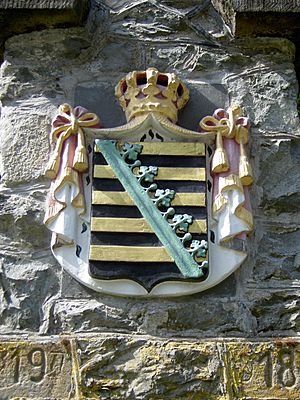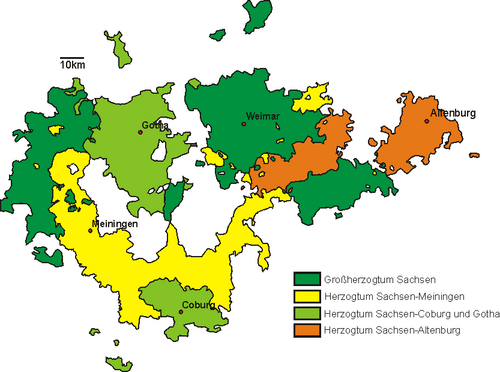Ernestine duchies facts for kids
The Ernestine duchies were a group of small states in what is now Thuringia, Germany. They were ruled by dukes from the Ernestine branch of the House of Wettin. These states were also sometimes called the Saxon duchies. They often changed in size and number over time. Other nearby states, like the Albertine duchies, were also sometimes called "Saxon duchies."
Contents
How the Duchies Started
The old Duchy of Saxony began to split up in the 1400s. This happened because a law said that all sons should inherit land. All sons of a Saxon duke received the title of Duke. Sometimes brothers ruled their land together. Other times, they divided it up among themselves. Some of the Ernestine duchies stayed independent until 1918. Other royal families in the area, like the Reuss and Schwarzburg families, also divided their lands. This made Thuringia a mix of many small states, with pieces of land (called exclaves and enclaves) scattered everywhere. This lasted from the late 1400s until the early 1900s.
Family History of the Ernestines
The story of the Ernestine duchies begins with the House of Wettin. Albert, a grandson of Albert "the Bear", inherited the Duchy of Saxony. His sons later divided Saxony into two duchies: Saxe-Lauenburg and Saxe-Wittenberg.
In 1422, the Duke of Saxe-Wittenberg died without any children to inherit his land. So, the Emperor Sigismund gave the duchy to Frederick IV of the House of Wettin. Frederick was already the Margrave of Meißen and Landgrave of Thuringia. He then became Frederick I, Elector of Saxony.
Frederick's son, Frederick II, became the next Elector. When Frederick II died in 1464, his sons Ernest and Albert took over. Ernest was the older brother, so he became Elector of Saxony. However, the brothers ruled the lands together until 1485. Then, they divided the land. Ernest took northern Meißen, southern Thuringia, and Wittenberg. Albert received northern Thuringia and southern Meißen. The Ernestine duchies came from Ernest's side of the family.
The Ernestine Family Line
Elector Ernest died in 1486. His son, Frederick III, the Wise, became the next Elector.
Frederick the Wise started the University of Wittenberg in 1502. He did this because the only other university in Saxony was in Leipzig. Leipzig was in the part of Saxony controlled by his uncle Albert's family. The University of Wittenberg became famous because Martin Luther posted his 95 Theses there. Frederick protected Luther and allowed Lutheran changes in his country.
Frederick the Wise had three grandsons who shared his land. John Frederick II made his main cities Eisenach and Coburg. His middle brother, John William, stayed in Weimar (Saxe-Weimar). The youngest, John Frederick III, took Gotha (Saxe-Gotha).
John Frederick III of Gotha died in 1565 without marrying or having children. John William of Weimar tried to claim Saxe-Gotha. But the sons of John Frederick II, who was in prison, also claimed the land.
In 1572, the family members agreed to the Division of Erfurt. This agreement said that John William of Saxe-Weimar would also get the areas of Altenburg, Gotha, and Meiningen.
When John William died a year later, his lands were divided again.
- His older son, Frederick William I, received Altenburg, Gotha, and Meiningen. He became the Duke of Saxe-Altenburg, starting the first Saxe-Altenburg family line.
- His younger son, John II, took Saxe-Weimar.
The older son of John Frederick II, and John Ernest (who died in 1638 without children), the younger son of John Frederick II, together received the land of Saxe-Coburg-Eisenach. In 1596, these brothers agreed to split their duchy into Saxe-Coburg and Saxe-Eisenach.
John II, Duke of Saxe-Weimar died young. He left eight sons who ruled together. Three of them died, including Bernard of Saxe-Weimar, a famous general. By 1639, only three brothers were left. They finally divided their lands, which were twice the size of what they had inherited. This happened after the lands of the Coburg-Eisenach dukes were split between the Altenburg and Weimar families.
William kept Weimar. Albert became Duke of Eisenach. Ernest, known as "the Pious," became Duke of Gotha.
Ernest I, Duke of Saxe-Gotha (1601-1675) married Elisabeth Sophie. She was the only child of John Philip, Duke of Altenburg (1597-1638). Elisabeth Sophie's cousin, Frederick William III, Duke of Altenburg, died in 1672 without marrying. He was the last male from the first Saxe-Altenburg family line.
There was a big disagreement about who should get the Altenburg land. In the end, most of it went to Ernest and Elisabeth Sophie's sons. About a quarter of the original Altenburg lands went to the Saxe-Weimar branch of the family.
These two main family lines, Weimar and Gotha-Altenburg, formed the basis of future Ernestine lines. Both of these lines still have male descendants today.
After the first Altenburg lands were divided, the older Ernestine branch (the Saxe-Weimar family) held just under half of all the Ernestine lands. The younger Gotha-Altenburg line held more than half. The Gotha-Altenburg line divided its land more often with each new generation. The Weimar line did not subdivide their land. By 1741, one branch of the Weimar family controlled all of their land. In 1815, they became Grand Dukes.
Duke Ernest of Gotha and Duchess Elisabeth Sophie had many sons. They divided their inheritance into seven parts: Gotha-Altenburg, Coburg, Meiningen, Römhild, Eisenberg, Hildburghausen, and Saalfeld. The new dukes of Coburg, Römhild, and Eisenberg had no children. So, their lands were quickly taken over by the four remaining lines.
Eventually, a rule called primogeniture became common. This meant that only the eldest son would inherit the land in the Ernestine Duchies.
In 1825, the Ernestine duchies were:
- The Grand Duchy of Saxe-Weimar-Eisenach (which was about three-eighths of all the Ernestine lands).
- The duchies of Saxe-Gotha-Altenburg.
- Saxe-Meiningen.
- Saxe-Hildburghausen.
- Saxe-Coburg-Saalfeld.
In 1825, the oldest line of Ernest the Pious, the Gotha-Altenburg line, ended. Their land was then divided and given out one last time.
Altenburg went to the Duke of Saxe-Hildburghausen. But he gave Hildburghausen to the Duke of Saxe-Meiningen-Hildburghausen. The Duke of Saxe-Coburg-Saalfeld gave up Saalfeld in exchange for Gotha. All of the Ernestine Duchies ended when Germany stopped having monarchies and princely states. This happened shortly after World War I.
Five rulers of the Ernestine duchies had a vote in the Holy Roman Empire’s Reichstag (a type of parliament). These were:
- Saxe-Weimar
- Saxe-Eisenach
- Saxe-Coburg
- Saxe-Gotha
- Saxe-Altenburg
In 1792, the Duke of Saxe-Weimar was also the Duke of Saxe-Eisenach. The Duke of Saxe-Altenburg was also the Duke of Saxe-Gotha. This meant both had two votes. The Duke of Saxe-Coburg had one vote.
Other Ernestine duchies were never part of the Imperial Circle. They were under the control of the five duchies that were part of it. For example, the areas of Meiningen and Hildburghausen were like this. This was one reason why the Duke of Hildburghausen traded his land for Altenburg. Later, in the German Confederation, all these states became equally independent.
List of Ernestine Duchies
- Saxe-Altenburg (1603 to 1672; 1826 to 1918)
- Saxe-Coburg (1596 to 1633; 1681 to 1699)
- Saxe-Coburg-Eisenach (1572 to 1596)
- Saxe-Coburg-Saalfeld (1735 to 1826)
- Saxe-Eisenberg (1680 to 1707)
- Saxe-Coburg and Gotha (1826 to 1918)
- Saxe-Eisenach (1596 to 1638; 1640 to 1644; 1672 to 1806)
- Saxe-Gotha (1640 to 1680)
- Saxe-Gotha-Altenburg (1681 to 1826)
- Saxe-Hildburghausen (1680 to 1826)
- Saxe-Jena (1672 to 1690)
- Saxe-Marksuhl (1662 to 1672)
- Saxe-Meiningen (1681 to 1918)
- Saxe-Römhild (1680 to 1710)
- Saxe-Saalfeld (1680 to 1735)
- Saxe-Weimar (1572 to 1806)
- Saxe-Weimar-Eisenach (1806 to 1918)
- John B. Freed. 1988. Saxony, in Strayer, Joseph R., Ed. in Chief. Dictionary of the Middle Ages, Vol. 10. Charles Scribner's Sons, New York. ISBN: 0-684-18276-9
- Wettin Dynasty. (2005). Encyclopædia Britannica. Retrieved December 12, 2005, from Encyclopædia Britannica Premium Service [1]
Images for kids
-
Ernest, Elector of Saxony (1441–1486)
-
Albert, Duke of Saxony (1443–1500)
See also
 In Spanish: Ducados ernestinos para niños
In Spanish: Ducados ernestinos para niños






